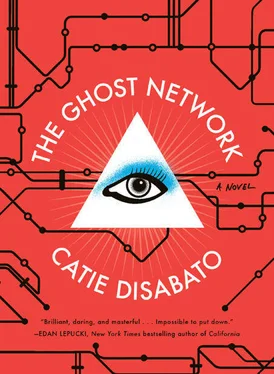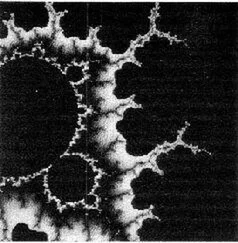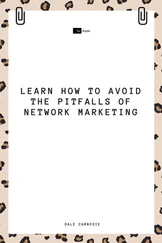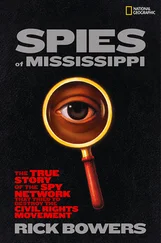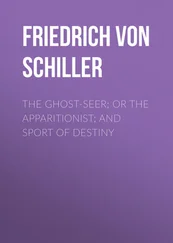Taer used MollyMaps’ search function to cross-check an L map or blueprint or L expansion proposal plan with The Ghost Network, but her favorite way to interact with The Ghost Network was to zoom in on the first station of a train line and examine the details of the area around each train station. Because MollyMaps’ core map had been stolen from Google, Taer could see the restaurants or parks or office buildings that had been built on land once considered a place for transport. When Taer picked a train line to examine in such detail, she rarely did so for a concrete reason. She chose her train lines impressionistically, because a color caught her eye or a particular curve in the line seemed interesting to trace. She moved between lines based on feeling; she was conducting her own virtual dérive through the fake train city that Molly had built.
While Taer and Berliner spent their days researching, Nix read about the Situationists, trying to come up with theories about what the New Situationists might’ve been hiding. She searched for various Situationist keywords in MollyMaps. She compared a collage called “The Naked City”—which Debord and Constant made using map fragments — to the painting of The Ghost Network on the wall, looking for repeated patterns.
At 5:30 p.m., Berliner insisted the working day was over. He worried the three of them would go insane if he didn’t impose some kind of forced down time. They ate dinner together every night. They frequented the nearby Italian and Mexican restaurants or picked up Chinese or Thai carryout. When they ate Chinese, they drank beer. At the Italian restaurant, they split two bottles of wine between the three of them, always red. They all ordered spicy dishes or passed a bottle of hot sauce around the table.
At dinner, they caught up on each other’s personal histories. Berliner told them about his exorcism; Taer tried to explain the way her drive to be a successful writer had shaped all of her emotional experiences since she was sixteen. Nix talked about being best friends in high school with another latent lesbian, watching Mulholland Drive and fast-forwarding through the sex scenes.
A few nights a week, Taer worked at Rainbo. On those nights, Berliner walked Nix back to the Urban Planning Committee’s headquarters and stayed with her until Taer returned. They watched movies: Videodrome , the Wachowskis’ lesbian heist movie Bound , and Kathryn Bigelow’s vampire movie Near Dark . They drank more. Sometimes, Berliner told her stories about Kraus. Nix wanted to hear everything about the strict regulations Berliner had to follow when he visited Kraus at the Dwight Correctional Center.
When Taer didn’t have to work, Berliner sometimes walked home alone, Taser in his pocket just in case. He was living in his Molly-built pied-à-terre at the time, occasionally entertaining his archive girlfriend, Johnson. Sometimes Berliner and Taer spent a few hours hanging out alone in a nearby beer bar, Local Option, Nix at home in the Urban Planning Committee headquarters, drinking and reading alone. Perched at the bar in front of a row of taps, sipping on tulip glasses full of highly alcoholic craft beers, Taer and Berliner debated the utility of psychogeography and détournement .
During our interviews, Berliner likened his friendships with Taer and Nix to an adolescent summer camp friendship. “Each hour in summer camp is the social equivalent of, basically, a week,” Berliner explained to me. “Romantic relationships that are eight hours old are practically marriages. Intense bonds form, clique loyalties are basically immobile once they coalesce. Then they’re over, just as fast.”
Berliner also told Taer his stories about Kraus, but Taer didn’t ask for more detail the way Nix did, preferring to debate at length whether Constant’s New Babylon could ever be built, and if it was built, if it could thrive. Berliner and Taer agreed it could somehow be built, but Berliner thought New Babylon would implode and Taer thought it could work. When Berliner asked Taer about her own relationship, she never said much, though more than once Taer told Berliner she was in love with Nix. Except for Taer’s one-on-one drinking sessions with Berliner and her nights at Rainbo, the young women spent all their time together, comfortable now in extreme geographical and physical closeness. They no longer knew what it was like to spend more than a few hours apart.
“We were ‘nesting,’ other dykes would call it,” Nix later told me. “It was shockingly wonderful to have this constant companion. Neither one of us had ever had a girlfriend like this before, someone we basically wanted to fuse with. To attach ourselves to so completely. Everything was very surreal, and we had this idea that maybe when things got ‘back to normal’ we would get torn away from each other. Which seemed overdramatic at the time but was, of course, what happened. So we were smart. We were smart to think our whole world was going to end.”
Some nights, they watched old episodes of Buffy the Vampire Slayer on Berliner’s Netflix account. Some nights, they played elaborate games of tag. §Some nights, when the wine had soaked her brain and Nix blurred in front of her tired eyes, Taer almost forgot about the absent pop star and their desperate search for what had happened. Some nights Taer and Nix did nothing but talk for hours. Some nights they lay in bed, not talking to each other, their heads jammed together on the same pillow.
While they worked during the day, Nix, Berliner, and Taer listened to music. Taer put on her favorite bad-mood albums: Elliott Smith’s Either/Or and a single by The Zombies, “Girl Help Me.” Nix and Berliner liked these albums as well. They played them dozens of times while Nix read biographies of Debord, Taer clicked her way through the digital copy of The Ghost Network, and Berliner re-read another L map. They sang along with “Girl Help Me,” and the Either/Or track “Between the Bars” in unison.
Perhaps because of the mood these albums created, Taer developed a vague but constant sense of ill ease. She started working at night, once Berliner had left and Nix had fallen asleep. She obsessively re-read portions of Molly’s notebook, as if trying to crack a code, or uncover a heretofore hidden reference to The Ghost Network or the New Situationists. Occasionally, Molly wrote about the specific maps incorporated into The Ghost Network, but those passages were observations, not conclusions, and littered with her thoughts and emotional responses to the information she was gathering — interesting on first read, but useless to her once she’d read the passages dozens of times. Molly also interrupted her discussions of the maps to make oblique references to her “Eye of Horus,” or “Third Eye,” or “Pyramid Eye,” which had something to do with the reasons she sometimes held one hand over one eye during publicity photo shoots. Taer couldn’t find any connection between these disparate parts of Molly’s notes, nor could she find a connection between The Ghost Network and Molly’s departure. She started to lose hope.
But on a warm April evening, almost seven weeks after Nix and Taer had found Berliner in the Urban Planning Committee headquarters, Taer found something.
* The Situationist City , 77.
† To explore further, psychogeography is the Situationists’ attempt to marry subjective and objective experiences of the city, the myriad ways that people interact with the cities they live in. From The Situationist City : “On one hand, [psychogeography] recognized that the self can’t be divorced from the urban environment, on the other hand, it had to pertain to more than just the psyche of the individual if it was to be useful in the collective rethinking of the city.”
Читать дальше
